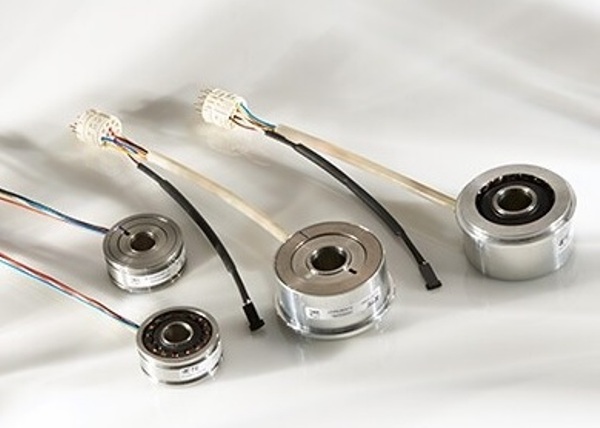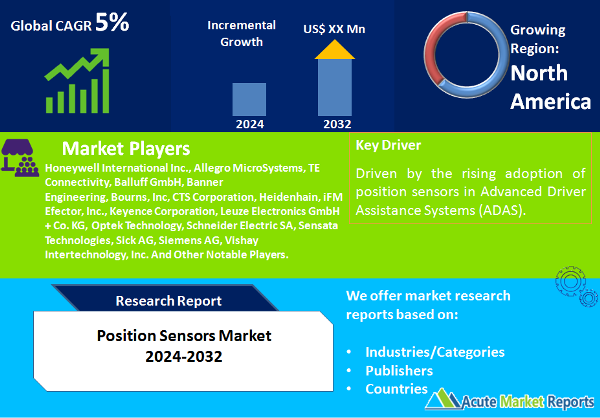
The position sensors market is a vital component of various industries, providing crucial data for automation, control systems, and robotics. The position sensors market is expected to grow at a CAGR of 5% during the forecast period of 2025 to 2033. The industry's commitment to technological advancements, precision measurement solutions, and diverse applications underscores its significance in shaping the future of automation, control systems, and robotics. As the market evolves, addressing challenges, fostering innovation, and adapting to the specific needs of different industries will be crucial for sustained growth in the position sensors market.
Advancements in Photoelectric Technology: Evidences of Enhanced Sensing Capabilities
The position sensors market is experiencing rapid growth driven by advancements in Photoelectric Technology. Evidence highlights the industry's focus on enhancing sensing capabilities, resulting in increased adoption of photoelectric sensors across diverse applications. In 2024, the market witnessed a surge in the use of photoelectric sensors, contributing significantly to overall revenue. These sensors, utilizing light-based technology for precise position detection, played a crucial role in industries such as manufacturing, automotive, and electronics. The highest Compound Annual Growth Rate (CAGR) from 2025 to 2033 is expected in Photoelectric Technology, showcasing its pivotal role in shaping the future of position sensing. This driver underscores the industry's commitment to innovation, pushing the boundaries of sensor capabilities and expanding their applications.
Growing Demand for Linear Position Sensors: Evidences of Increasing Need for Linear Measurement Accuracy
The position sensors market is witnessing a growing demand for Linear position sensors, driven by the increasing need for precise linear measurement accuracy. Evidence indicates a shift towards linear sensors in applications where accurate measurement of linear displacement is critical, such as in robotics and automation. In 2024, the market experienced substantial revenue from linear position sensors, reflecting their importance in various industries. Linear position sensing is expected to exhibit the highest CAGR during the forecast period from 2025 to 2033, indicating sustained demand for accurate linear measurement solutions. This driver highlights the industry's response to the demand for higher precision in applications requiring linear position detection.

Rising Adoption of Position Sensors in Automotive: Evidences of Integration in Advanced Driver Assistance Systems (ADAS)
The position sensors market is experiencing a surge in adoption within the automotive sector, particularly in Advanced Driver Assistance Systems (ADAS). Evidence suggests the integration of position sensors in vehicles to support functionalities such as collision avoidance, parking assistance, and lane departure warning systems. In 2024, the automotive industry contributed significantly to the market's revenue, with the highest CAGR expected in this sector during the forecast period from 2025 to 2033. This driver reflects the industry's recognition of position sensors as integral components for enhancing vehicle safety and performance. As automotive technologies continue to advance, the demand for position sensors is expected to grow, further solidifying their position in the automotive sector.
Challenges in Proximity Sensor Applications: Navigating Limitations in Specific Environments
A significant restraint in the position sensors market is associated with challenges in Proximity Sensor applications. Evidence includes limitations in specific environments where proximity sensors may face interference or accuracy issues. In 2024, these challenges posed hurdles to the widespread adoption of proximity sensors, particularly in environments with high electromagnetic interference or harsh operating conditions. This restraint is underscored by the need to overcome technical limitations and ensure the reliability of proximity sensors across diverse applications. As the market addresses these challenges, stakeholders are tasked with developing solutions that enhance the robustness and adaptability of proximity sensors, ensuring their effectiveness in various industrial settings.
By Technology: Photoelectric Technology Dominates the Market
In 2024, the position sensors market showcased substantial revenue from advancements in Photoelectric Technology, indicating the industry's keen interest in enhancing sensing capabilities. Linear position sensors also contributed significantly to overall revenue, reflecting the increasing demand for precise linear measurement accuracy in various applications. Proximity Sensors faced challenges but maintained a notable presence in the market. The highest CAGR during the forecast period from 2025 to 2033 is expected in Photoelectric Technology, emphasizing its role as a key driver shaping the future of position sensing technology. This segmentation highlights the market's diverse technological landscape and the specific areas driving growth.
By Application: The Automotive Sector Dominates the Market
The market exhibited a strong demand for Linear position sensors in 2024, with industries seeking accurate linear measurement solutions. The automotive sector emerged as a major contributor to market revenue, driven by the rising adoption of position sensors in Advanced Driver Assistance Systems (ADAS). Other applications, including military & aerospace, electronics & semiconductors, and packaging, also played crucial roles in shaping the market landscape. The highest CAGR during the forecast period from 2025 to 2033 is expected in Linear position sensors, signifying sustained demand for precise linear measurement solutions. This segmentation underscores the diverse applications of position sensors across industries, each contributing to the market's overall growth.
North America Remains the Global Leader
Geographically, the position sensors market demonstrated dynamic trends in 2024, with North America leading in both revenue generation and the highest CAGR. This reflects the region's advanced technological infrastructure and the continuous demand for position-sensing solutions. Europe also contributed substantially to revenue, with a slightly lower CAGR indicative of mature but steady growth. The Asia-Pacific region exhibited the highest CAGR, highlighting the increasing adoption of position sensors in emerging economies with a focus on industrial automation and technological advancements. This geographic segmentation underscores the global nature of the position sensors market, with different regions playing distinct roles in shaping its trajectory.
Market Competition to Intensify during the Forecast Period
In the competitive landscape, top players such as Honeywell International Inc., Allegro MicroSystems, TE Connectivity, Balluff GmbH, Banner Engineering, Bourns, Inc, CTS Corporation, Heidenhain, iFM Efector, Inc., Keyence Corporation, Leuze Electronics GmbH + Co. KG, Optek Technology, Schneider Electric SA, Sensata Technologies, Sick AG, Siemens AG, and Vishay Intertechnology, Inc. play pivotal roles in steering the position sensors market. These industry leaders, with their extensive product portfolios, global presence, and strategic collaborations, significantly influence market dynamics. In 2024, these companies reported substantial revenues, setting the tone for competitive trends. The overall outlook of the market is characterized by innovation, strategic partnerships, and a focus on meeting the evolving needs of diverse industries. As the market progresses from 2025 to 2033, the competitive landscape is expected to witness further dynamism, with key players continuing to drive advancements in position-sensing technology.
Historical & Forecast Period
This study report represents analysis of each segment from 2023 to 2033 considering 2024 as the base year. Compounded Annual Growth Rate (CAGR) for each of the respective segments estimated for the forecast period of 2025 to 2033.
The current report comprises of quantitative market estimations for each micro market for every geographical region and qualitative market analysis such as micro and macro environment analysis, market trends, competitive intelligence, segment analysis, porters five force model, top winning strategies, top investment markets, emerging trends and technological analysis, case studies, strategic conclusions and recommendations and other key market insights.
Research Methodology
The complete research study was conducted in three phases, namely: secondary research, primary research, and expert panel review. key data point that enables the estimation of Position Sensors market are as follows:
Market forecast was performed through proprietary software that analyzes various qualitative and quantitative factors. Growth rate and CAGR were estimated through intensive secondary and primary research. Data triangulation across various data points provides accuracy across various analyzed market segments in the report. Application of both top down and bottom-up approach for validation of market estimation assures logical, methodical and mathematical consistency of the quantitative data.
| ATTRIBUTE | DETAILS |
|---|---|
| Research Period | 2023-2033 |
| Base Year | 2024 |
| Forecast Period | 2025-2033 |
| Historical Year | 2023 |
| Unit | USD Million |
| Segmentation | |
Technology
| |
Application
| |
|
Region Segment (2023-2033; US$ Million)
|
Key questions answered in this report